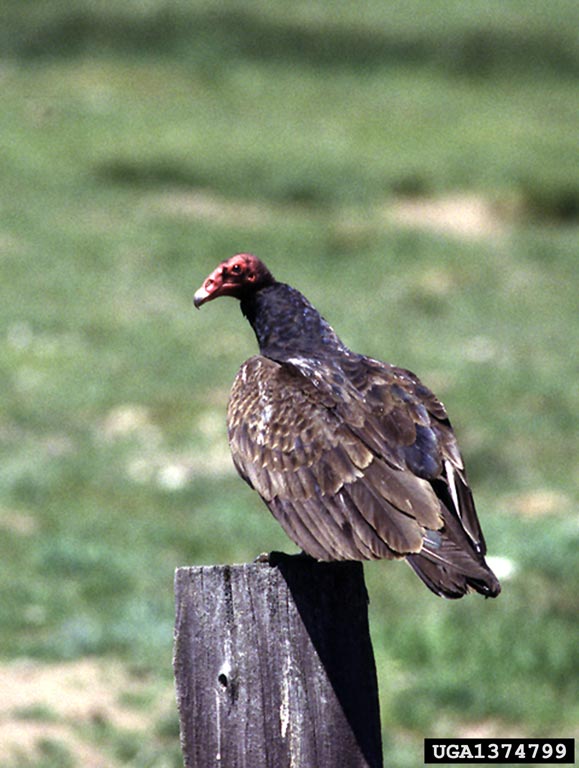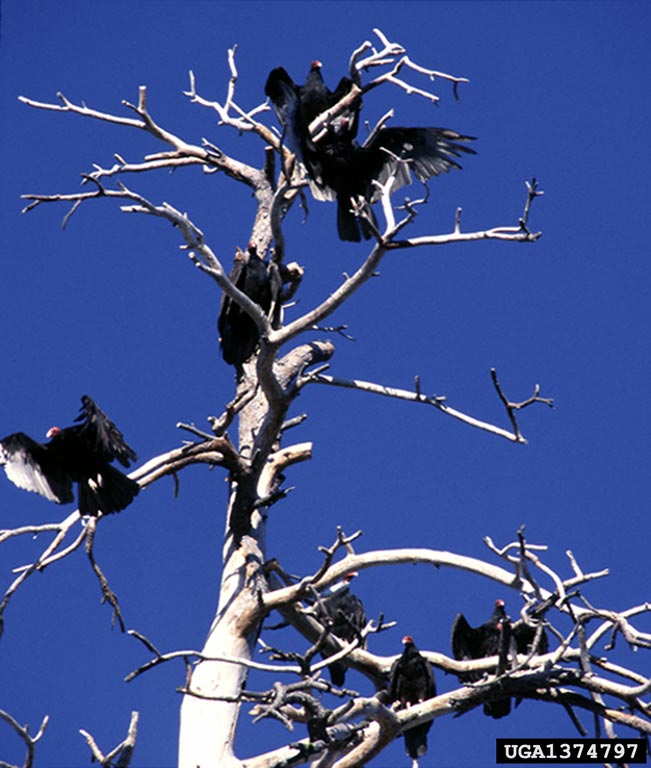 Turkey Vultures - April 17, 2019 Jeff Schalau, Agent, Agriculture & Natural Resources University of Arizona Cooperative Extension, Yavapai County Turkey vultures (Cathartes aura) are seasonal residents of the Verde Valley and cooler regions of the U.S. and southern Canada. In the desert southwest and southeast, they may stay year round. In flight, they soar with their wings in a slightly raised “V” often circling as they forage for freshly deceased carcasses. Turkey vultures are dark brown with a featherless red head and pale bill. While most of their body and forewing are dark, the undersides of the flight feathers (along the trailing edge and wingtips) are lighter gray, giving a distinct two-toned appearance. Their bald heads help them eat without getting carrion on their feathers. Turkey vultures are graceful but unsteady flyers using very few wingbeats. They often glide relatively low to the ground or else riding thermals up to higher vantage points. They may soar in small groups and/or roost in larger numbers. You may also see them on the ground, huddled around roadkill or in garbage dumpsters. They occupy a diverse array of habitats from rural to urban areas. On sunny days, they take flight in the morning and in colder weather and at night they roost on poles, towers, dead trees, and fence posts. They often sit in the sun and spread their wings on cold mornings to warm up before flying. Turkey vultures eat carrion, which they find largely by their excellent sense of smell. Mostly they eat mammals but will also feed on dead reptiles, birds, amphibians, fish, and even invertebrates. They prefer freshly dead animals, but often have to wait for their meal to soften in order to pierce the skin. They are deft foragers, targeting the softest areas of the carcass first. Thankfully for them, vultures appear to have excellent immune systems, happily feasting on carcasses without contracting botulism, anthrax, cholera, salmonella, or other pathogens. Turkey vultures almost never attack living prey. Turkey vultures were once threatened by side-effects of the pesticide DDT, but today they are a common sight during the summer months in Northern Arizona. Like California Condors, Turkey Vultures can fall victim to poisons or lead in dead animals. The main concern is lead shot that ends up in carcasses or gut piles left by hunters. Turkey Vultures may inadvertently eat the shot and eventually suffer from lead poisoning. Other threats include trapping and killing due to erroneous fears that they spread disease. Turkey Vultures actually slow the spread of disease by consuming dead animals. Turkey vultures are monogamous and nest on exposed ledges, in caves, tree hollows, abandoned hawk or heron nests, and abandoned buildings. These nest sites are typically much cooler (by 13°F or more) than surrounding areas, and isolated from human traffic or disturbance. The female scrapes an indentation in the substrate and usually lays only two eggs. Both parents share in incubating the eggs and the feeding of the chicks when they hatch. While they often feed near humans, turkey vultures prefer to nest far away from civilization. The chicks are fed regurgitated food by both parents and will fledge the nest in 9 to 10 weeks with family groups remaining together until fall. If the young in the nest are threatened, the parents may regurgitate, often for a distance of 10 feet, to defend their young from predators. When this occurs, the putrid smell of the rotting flesh mixed with the acids of the stomach becoming a very repulsive experience for a predator. Some biologists have surmised that regurgitation also allows them to reduce their weight quickly for an emergency takeoff. Another repellent habit of turkey vultures is their habit of defecating on their feet during hot weather to reduce their body temperature. If not nesting, turkey vultures often roost in standing dead trees. I once came upon one of these trees – I knew because the ground underneath the tree was “whitewashed” with fecal matter. Being evening, the turkey vultures were there roosting and I made a hasty retreat. I can think of better ways to cool off in summer. Visit the on-line version (see URL below) to see photos and additional information about turkey vultures. Follow the Backyard Gardener on Twitter – use the link on the BYG website. If you have other gardening questions, call the Master Gardener help line in the Camp Verde office at 928-554-8992 or e-mail us at verdevalleymg@gmail.com and be sure to include your name, address and phone number. Find past Backyard Gardener columns or provide feedback at the Backyard Gardener web site: http://cals.arizona.edu/yavapai/anr/hort/byg/. Additional Resources Turkey Vulture, All About Birds, The Cornell Lab of Ornithology www.allaboutbirds.org/guide/Turkey_Vulture/ Vulture Culture, Arizona-Sonora Desert Museum www.desertmuseum.org/vultures/ Photos  Adult Turkey Vulture, Terry Spivey, USDA Forest Service, Bugwood.org  Roosting Turkey Vultures, Terry Spivey, USDA Forest Service, Bugwood.org
Roosting Turkey Vultures, Terry Spivey, USDA Forest Service, Bugwood.org |